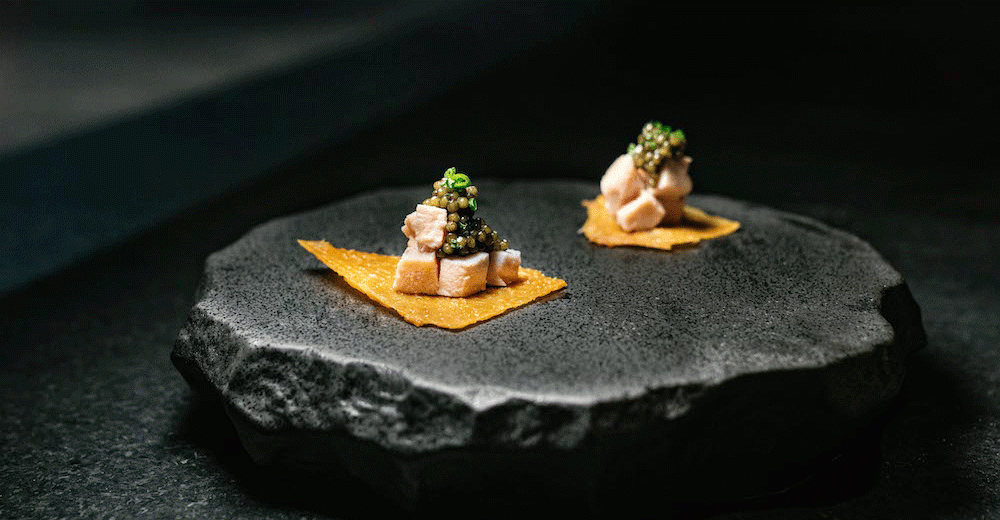1 5
For this dish at Kono, an omakase restaurant that opened last month in Manhattan’s Chinatown, executive chef and partner Atsushi “ATS” Kono offers this two-bite canapé as the first dish of his tasting menu. The chicken skins are baked and then deep-fried to make a crispy chip and then topped with a salad of chicken breast that has been marinated in kombu, cooked in sous-vide and then mixed with creamy tofu and the Japanese ginger myoga. It’s garnished with caviar, chives and lime zest.
Price: Part of the $165 omakase menu
At Tia Carmen, which opened at the end of April at the JW Marriott Phoenix Desert Ridge Resort & Spa, executive chef and founder Angelo Sosa makes this dish inspired by Chinese dandan noodles. He uses mesquite pods, which are used in the Southwest to make flour, grinds them and mixes them with water and salt to make the noodles.
He seasons local lamb with New Mexican Chimayo chiles and Hatch green chiles, paprika, cumin and Szechuan peppercorns and slowly braises it with corn, carrots and tomatoes. He skims the lamb fat and tosses the noodles in that. He plates the lamb, tops it with the noodles and garnishes the dish with cilantro and epazote.
“The mesquite flour in the noodle dough contains a little sweetness,” Sosa said. “The sweetness contrasts the gaminess [of the lamb] and the eucalyptus notes of the Szechuan peppercorns and balances the dish out ever so beautifully.”
Price: $20
The Wash is a former carwash in Nashville that has been turned into an incubator for restaurants and bars, including Bay 6, where beverage director and managing partner Beau Gaultier offers this drink, named for a quote from writer Wendell Berry about managing land carefully, so it stands to reason that it’s low on waste.
He starts by infusing a liter of cachaça with the 30 grams of spent grounds of Café du Monde coffee, which is dark roast coffee blended with chicory. He lets that sit for two hours and strains it through a fine mesh sieve.
Separately he combines the husk of one pineapple with 350 grams of sugar and 35 grams of citric acid and lets that sit for at least two hours, but up to a day. Then he adds 250 grams of day-old pineapple juice, stirs it and strains it.
He combines 2 ounces of the coffee cachaça with 1.5 ounces of the acidified pineapple syrup, shakes them with ice and strains that through a fine mesh sieve into a coupe that he garnishes with a dehydrated lime wheel.
“The result is a Cuban Daiquiri-esque cocktail that starts juicy but ends bitter,” Gaultier said. “Every ingredient is a complimentary flavor of every other one: Chicory plays nice with coffee, coffee goes great with funky cachaça, and cachaça and pineapple are a match made in heaven.”
He added that, although it’s a relatively labor-intensive drink on the back end, at service it just requires two touches, saving a lot of time. Also, the use of citric acid and leftover parts of the pineapple make it much less expensive than using fresh lemon or lime juice.
Price: $15
At Planta, a group of 10 vegan restaurants based in Miami, David Lee, executive chef of the Asian-themed Planta Queen concept, and culinary directors Frances Tariga and Tabitha Yeh, developed this dish for Asian American and Pacific Islander Heritage Month, which is May.
They braise daikon in vegetable broth, bread it in panko breadcrumbs and then serve it on a bao bun with pickled red cabbage and cucumber and sweet & sour sauce, creating a meatless version of what’s normally a pork dish.
Price: $8
Bar Beau in the Brooklyn, N.Y., neighborhood of Williamsburg, is celebrating strawberry season with several seasonal menu items including this one, for which executive chef Gemma Kamin-Korn tears red leaf lettuce and tosses it with sliced strawberries, rhubarb and red onion in a vinaigrette made with Champagne and balsamic vinegars, honey and a heavy dose of Dijon mustard.
It's garnished with freeze-dried strawberries for added sweetness and beet chips “for an earthy dimension and crunch.”
Price: $16

